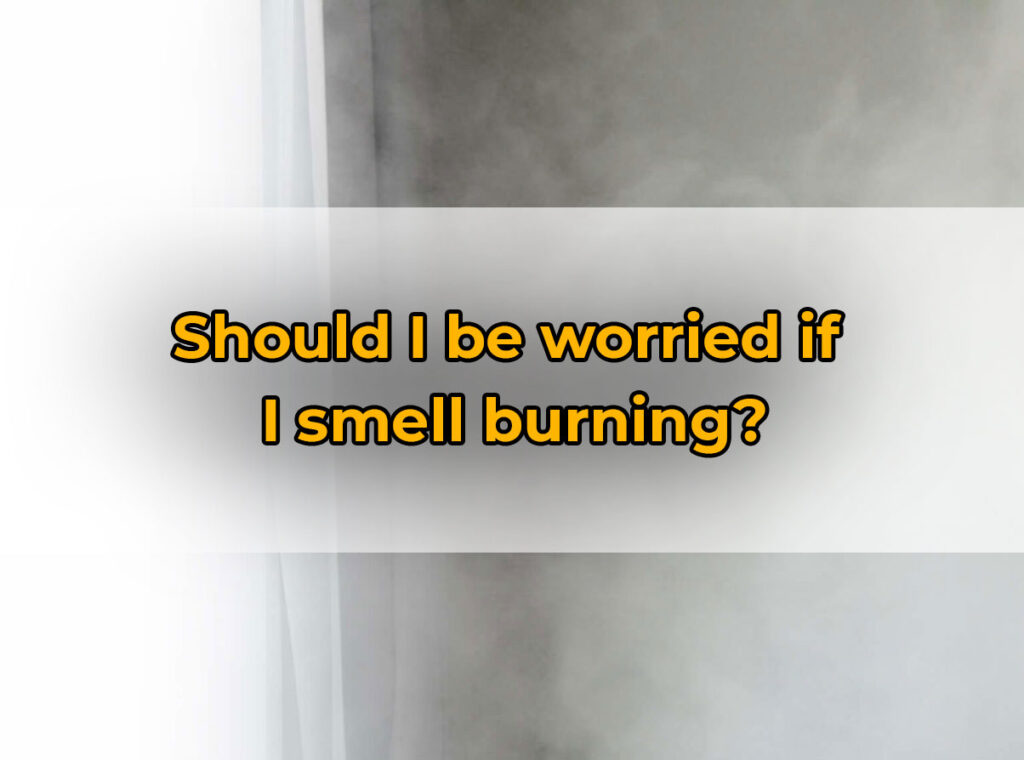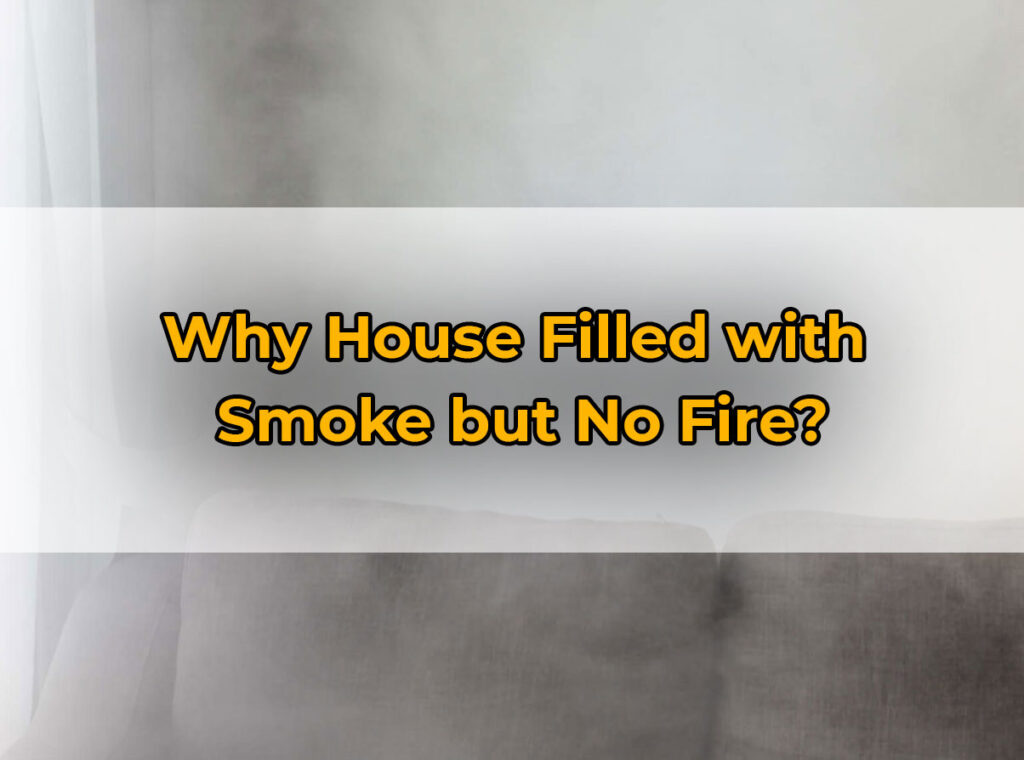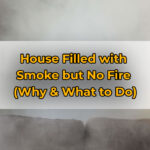Surprised with your house filled with smoke but no fire? A house filled with smoke but no fire can be a scary and perplexing experience. Panic and fear may arise as you wonder what is causing the smoke. It is essential to remain calm and take immediate action.
Visibility will be reduced. Crouch low and use a wet cloth or mask to cover your nose and mouth. This will protect you from inhaling dangerous substances.
The smoke could be from an appliance, furnace, or stove. Find the source and close doors and windows in that area if it is safe.
Call emergency services right away. Give them your location. Gather in a safe area away from the smoke while you wait for help.
In a smoke-filled house, stay calm, assess the surroundings, and seek help promptly. This is the best way to ensure everyone’s safety.
Should I be worried if I smell burning?

YES! you should be worried if you found your house filled with smoke but no fire! While it may not always indicate a serious problem, it is crucial to assess the situation promptly to ensure the safety of your household.
In some cases, the source of the burning smell could be harmless and easily rectified, such as a forgotten piece of toast in the toaster or dust accumulating near an electrical socket. However, there are instances where this odor can signify more significant issues that require immediate attention.
If you smell burning in your house and cannot pinpoint its origin, it is essential to act cautiously. First and foremost, check for any visible signs of fire or smoke. If you notice flames or smoke, evacuate everyone from the premises immediately and call emergency services.
Why House Filled with Smoke but No Fire?

A strange event happened recently. A house filled with smoke but no fire. Why? The puzzle remains unsolved. People around were scared. The fire department came to help.
But there was nothing to put out! Investigators inspected the house but found no source of the smoke. Here are the things that possibly happen why house filled with smoke but no fire:
1. Electrical Issues
One common culprit behind a house filled with smoke but no fire is faulty wiring. Over time, electrical systems can deteriorate, leading to loose connections or frayed wires.
When these defects occur, they can generate heat and produce smoke without sparking an actual fire. It is crucial to have your electrical system regularly inspected by a professional to identify any potential hazards before they escalate into dangerous situations.
Another possible cause for a house filled with smoke but no fire is overheating appliances or devices. Many household electronics are prone to overheating if not properly maintained or used incorrectly.
2. Heating System Problems
When the furnace fails to ignite properly, it can cause an accumulation of unburned fuel, resulting in the release of smoke throughout your home. This problem may be caused by various factors such as clogged burners, faulty ignition systems, or malfunctioning sensors.
Another possible cause is a cracked heat exchanger, which allows combustion gases to escape into the air ducts and circulate through your home.
3. Blocked Chimney or Flue
A chimney serves as an essential ventilation system that safely removes the byproducts of combustion from your home. However, when it becomes obstructed, whether due to debris buildup or animal nests, the smoke has nowhere to escape and fills up your living space instead. The consequences can be not only irritating but also hazardous to your health.
The presence of excessive smoke in your home without an actual fire can cause respiratory issues and eye irritation due to the inhalation of harmful particles. It can also leave behind foul odors and unsightly stains on walls and ceilings. To prevent this scenario from occurring, regular chimney maintenance is crucial.
4. Cooking Mishaps
Whether it’s leaving something on the stove for too long or forgetting about that casserole in the oven, burnt food can quickly fill your home with thick smoke. The intense heat breaks down the organic matter in the food, releasing volatile compounds that create an unpleasant and potentially hazardous smoky atmosphere.
Another reason for a smoke-filled house is grease buildup. Over time, cooking oil and grease can accumulate on your stovetop or inside your oven. When these greasy surfaces are exposed to high temperatures during cooking, they can produce significant amounts of smoke. Check also: House Smells like Gas but No Leak.
5. Cigarette Smoke
Cigarettes contain various chemicals and toxins that can linger in the air long after they have been extinguished. When someone smokes indoors, these particles can accumulate on surfaces such as walls, furniture, and carpets. As time passes, the residue can release into the air again, creating a haze of smoke that gives the illusion of a burning fire.
The main reason behind cigarette smoke causing a house to fill with smoke but no fire is due to the particles becoming embedded in porous materials within your home. These microscopic particles are known as third-hand smoke and consist of both gases and solid substances. They attach themselves to surfaces and slowly release back into the atmosphere over time.
6. HVAC Issues
Problems with your heating, ventilation, and air conditioning (HVAC) system, such as clogged filters or malfunctioning components, can cause smoke to spread throughout the house.
One common cause of smoke-filled houses is a malfunctioning furnace. If the heat exchanger inside the furnace cracks or deteriorates over time, it can leak combustion gases into your home instead of venting them outside. This leakage results in smoke filling up your living spaces without any visible flames. Regular maintenance and timely inspections by professionals are crucial to ensure that your furnace is functioning properly and prevent potential hazards.
Another reason for a house filled with smoke could be clogged air filters.
What to do When House Filled with Smoke but No Fire?

It can be a frightening experience to find your house filled with smoke but no fire, even more so when you can’t locate the source of the fire. Check also: Installing Fire Sprinkler System.
However, it’s essential to stay calm and take immediate action to ensure your safety and prevent any potential damage. Here is what to do to troubleshoot this problems:
1. Ventilate the House
The first thing to do to fix house filled with smoke but no fire is to open all windows and doors to create a cross draft that will help ventilate the space. This will allow fresh air to enter while pushing out the smoky air, gradually clearing the atmosphere inside.
In addition to opening windows and doors, turning on fans or exhaust systems can further aid in improving ventilation. Utilize any ceiling fans or portable fans you have throughout the house.
If you have an exhaust system in your kitchen or bathroom, switch it on as well. These fans will help circulate the air more efficiently, expelling smoke particles at a faster rate.
2. Check Appliances
Begin by turning off all electrical devices and unplugging them from the wall sockets. This will help prevent any potential hazards while you investigate.
Next, carefully inspect each appliance for visible signs of damage or burning. Pay close attention to cords, switches, and plugs that may have become frayed or melted due to overheating.
If you identify any damaged components or suspect an appliance is causing the smoke, refrain from using it further and consider calling a professional repair service instead. Check also: Oven Smells like Gas When Preheating.
3. Inspect HVAC System
The HVAC system plays a crucial role in circulating air throughout the house, and if there is an issue within the system, it could result in smoke filling up your living space.
Start by checking the vents and registers around your home. Make sure they are unobstructed and not clogged with dust or debris. If you notice any blockages, clear them out carefully using a vacuum cleaner or a brush.
Next, examine the air filter in your HVAC unit. A dirty or clogged filter can restrict airflow and cause smoke to accumulate indoors.
4. Check Chimney and Flue
Sometimes, a blocked or malfunctioning chimney can be the culprit behind the mysterious smoke invasion.
Begin by ensuring that your fireplace damper is fully open, as a closed damper can cause smoke to backdraft into your home. Next, grab a flashlight and head outdoors to inspect the chimney from ground level. Look for any visible signs of blockage such as bird nests or debris that may have accumulated over time.
If you don’t spot any obvious obstructions from the outside, it’s time to investigate further inside your home. Start by examining the fireplace itself; check for creosote buildup on the walls of the flue or any loose bricks which could indicate damage.
5. Investigate Cooking Area
Start by turning off any heat sources in the kitchen, such as stovetops or ovens. This will prevent any potential hazards from escalating further.
Next, check if there are any pots or pans on the stove that may have been left unattended or overheated. Sometimes a forgotten pot can smolder and produce significant amounts of smoke without igniting into flames.
6. Inspect Electrical Wiring
Faulty or damaged electrical wiring can lead to overheating, sparking, and eventually smoke. Start by turning off the power at the main breaker or fuse box to ensure your safety before proceeding.
Once the power is off, carefully examine all visible electrical wires for any signs of damage such as frayed insulation, exposed wires, or loose connections.
Pay close attention to areas where wires are connected or joints are present as these are common trouble spots. It’s also crucial to check outlets and switches for any burn marks or unusual odors which could indicate an electrical issue.
7. Be Prepared to Call for Help
If the smoke persists or you cannot identify the source of the smoke, be prepared to call the fire department or emergency services for further assistance.
8. Stay Safe
While investigating, be cautious and aware of your surroundings. If you encounter any signs of fire or if the smoke becomes too thick, evacuate the house immediately and call for help.
If there is thick smoke while evacuating, stay close to the ground and crawl if necessary. Smoke rises, and the air near the floor is usually less filled with smoke and toxic gases.
Is it safe to sleep in a smoky house?
NO! Smoke inhalation can have serious health consequences, making it crucial to understand the risks associated with sleeping in a smoky environment. When a fire occurs, smoke particles and toxic gases are released into the air, posing significant dangers to the respiratory system. Breathing in these harmful substances can lead to irritation of the throat, coughing, shortness of breath, and even lung damage.
Sleeping in a smoky house increases your exposure to these hazardous elements for an extended period. The longer you remain in an environment filled with smoke particles, the higher the risk of developing severe respiratory issues. Additionally, certain individuals may be more vulnerable than others when exposed to smoke while sleeping.
How long does it take for smoke to clear out of a house?
In general, it can take anywhere from a few hours to several weeks for smoke to completely clear out of a house. If the fire was small and contained quickly, with minimal damage and proper ventilation, you may expect the smell and presence of smoke to disappear within 24-48 hours.
Does washing walls get rid of smoke smell?
Yes, washing the walls can certainly help eliminate some of the smoke smell, but it may not completely eradicate it. Smoke particles have a tendency to penetrate deep into porous surfaces such as drywall and wallpaper, making them difficult to remove by simple cleaning methods.
Washing the walls with a mixture of warm water and mild detergent can be effective in reducing surface-level smoke residue. However, for more stubborn odors that have seeped deeper into the walls, additional steps may be necessary.
One option is to use a specialized cleaning product designed specifically for removing smoke smells. These products often contain enzymes or other odor-neutralizing ingredients that can break down and eliminate the remaining odorous compounds.
“There is no real ending. It’s just the place where you stop the story.”






